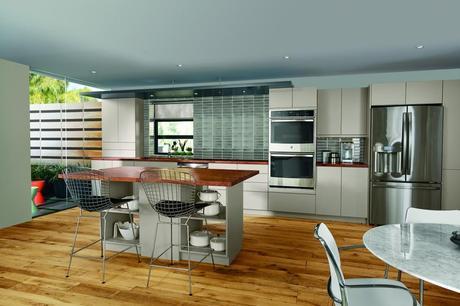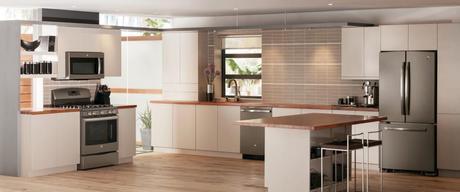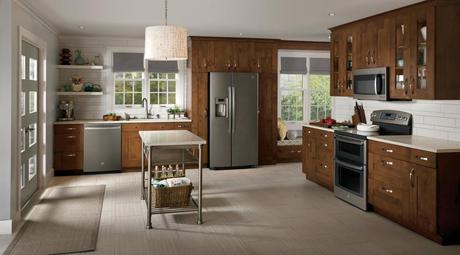
In 2012, the National Kitchen and Bath Association noticed a surprising trend. For the first time since the organization had been tracking design trends, “traditional” style did not top their list for top trends in kitchen and baths. Instead, “transitional” design trumped the rankings.
For those of use who are not up on all the industry buzzwords, the short explanation “transitional” design is a blend of contemporary modern styling with traditional elements.
Not satisfied with that short answer though, we asked Kevin Laundroche, GE’s Chief Designer of appliances. We found Kevin to be a great person to ask about this trend shift, because GE has been adapting its Profile appliances and other lines to comply with the national trend towards transitional.
Goedeker’s: What is exactly is transitional design?

Kevin Laundroche, Chief Designer of GE Appliances
Kevin Laundroche: Simply stated, “Transitional design” is the blending of design motifs from traditional and contemporary. It softens the hard edges of contemporary and cleans up all the excesses of traditional design characteristics. Obviously that is a very general statement that has many ways to be resolved.
Basically, “transitional design” uses clean pallet of color with accents of other sophisticated colors. To strip a room bare of all amenities and start from the beginning would have a look that would be similar to: walls can either be white, off white, light grey, tan, or taupe (clean light and airy). Flooring would be natural wood, tiling, or a low pile carpet with lighter color pallet to compliment the walls. Cabinetry or furniture would either stay light color to carry the lightness of the room or have a wood finish. It is where you can start to have some contrast to the walls. Hardware on cabinets are simple and straight forward yet evoke quality through noble through the use of materials like brushed stainless steel, brushed nickel, or subtle sympathetic colors.
There are many variations to what transitional is; it is taking what is comfortable and making it simple, so that living in combined spaces doesn’t become to cluttered.
Goedeker’s: Why do you think this new shift from traditional to transitional is taking place now?
Kevin: In the current new housing market, there has been a shift from very large houses to homes that are smaller. The fact that these new homes have become smaller means the design of the house has to still look roomy and comfortable. The interior has to become far more versatile with the allotted space and still maintain the value proposition for both the builder and the buyer. That means the traditional dining room, kitchen, and living room or family room are being merged together into one bigger space. The cost of square footage in building, the cooking as entertainment movement, and smaller families likely all contributed to this shift.
Whatever lever eventually moved housing development in this direction also caused interior design preferences to change as well. While traditional decoration motifs tended to be visually heavy with dark or high contrast decoration colors, this design became too big of a design statement as the nature of how living spaces changed and are being built and lived in today. Transitional design motifs are perfect to meet those specific challenges for smaller combined living spaces.

Goedeker’s: What examples can you give in the redesign of the GE Profile™ series and other GE appliances that exemplify transitional design?
Kevin: As we introduce our new line of GE appliances, it has been carefully crafted to fit within not only transitional designs but traditional and contemporary as well. We did this by taking “the appliance is not the hero” approach. Our new appearance is specifically designed to fit the vision of your kitchen not the other way around. We made the lines of the appliances fit better with the architecture of the kitchen by using a more minimal approach to not only form, but also to the accent colors.
For example, in the past we used black and stainless steel which had high contrast, we now use a softer warmer dark gray that tones down the contrast of the appliance while still giving you the quality in appearance and performance. We also made our handles more linear in nature but still paid attention to the detail of handle comfort and proportion to give you ample space to fit your hand and have a quality feel as you open and close your GE appliances.
Another area where we spent considerable time was in the control panels. We have type that’s large enough to read easily, but with colors that compliment but don’t overwhelm the user. Overall it we believe our new appearance for GE is the best solution on the market today for people wanting to give their kitchens an upgrade in not only performance, but also a beautiful aesthetic.

Goedeker’s: Besides appliances, what are some ways I can change my kitchen’s decor from traditional to transitional?
Kevin: I would recommend simplification. If you have raised panel cabinet doors, you could change them to flat doors with new hardware. If that is not in the budget, try painting them to a lighter color. I live in a traditional house myself. The one thing I’ve done is to paint the walls light, and the ceiling, door, and floor trims the same color but only high gloss. Transitional style is about light and airy, with accents of darker, complimentary colors. Restraint is key. My choice of wood accents with my light walls is a light cherry wood for cabinets. I’m sure that there are many other choices that would also be brilliant combinations.
Goedeker’s: Traditional design in kitchens and baths has long been the most popular style. What are your thoughts on transitional style’s future?
Kevin: I believe the transitional style will be the mainstay of the market. It is a common ground between two distinct genres, but we should expect to see extremes as well. Transitional is flexible and can be used in many ways, which is why it will be around for a long time.
You may also be interested in our interviews with GE Artistry Designer Tomas DeLuna and Chris Bissig, who developed GE’s Slate finish if you are would like to read more about GE’s recent developments in following appliance and home design trends.

